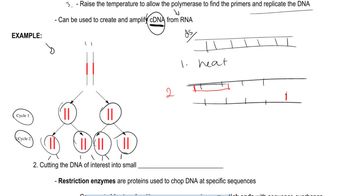Table of contents
- 1. Introduction to Genetics51m
- 2. Mendel's Laws of Inheritance3h 37m
- 3. Extensions to Mendelian Inheritance2h 41m
- 4. Genetic Mapping and Linkage2h 28m
- 5. Genetics of Bacteria and Viruses1h 21m
- 6. Chromosomal Variation1h 48m
- 7. DNA and Chromosome Structure56m
- 8. DNA Replication1h 10m
- 9. Mitosis and Meiosis1h 34m
- 10. Transcription1h 0m
- 11. Translation58m
- 12. Gene Regulation in Prokaryotes1h 19m
- 13. Gene Regulation in Eukaryotes44m
- 14. Genetic Control of Development44m
- 15. Genomes and Genomics1h 50m
- 16. Transposable Elements47m
- 17. Mutation, Repair, and Recombination1h 6m
- 18. Molecular Genetic Tools19m
- 19. Cancer Genetics29m
- 20. Quantitative Genetics1h 26m
- 21. Population Genetics50m
- 22. Evolutionary Genetics29m
15. Genomes and Genomics
Functional Genomics
Problem 5a
Textbook Question
What are the advantages and disadvantages of using insertion alleles versus alleles generated by chemicals (as in TILLING) in reverse genetic studies?
 Verified step by step guidance
Verified step by step guidance1
Understand the concept of reverse genetics, which involves studying gene function by analyzing the phenotypic effects of specific gene sequences obtained by mutating or deleting the gene.
Identify the nature of insertion alleles, which are created by inserting a piece of DNA into a gene, often disrupting its function. This can be achieved using transposons or T-DNA insertions.
Recognize the advantages of insertion alleles: they often result in complete loss-of-function mutations, are relatively easy to identify using molecular techniques, and can be stable and heritable.
Understand the nature of alleles generated by chemical mutagenesis, such as those used in TILLING (Targeting Induced Local Lesions IN Genomes), which involves treating organisms with chemicals that induce point mutations.
Compare the disadvantages: insertion alleles can sometimes cause unintended effects due to insertional mutagenesis, while chemical mutagenesis can result in a wide range of mutations, making it challenging to identify the specific mutation responsible for a phenotype.
Recommended similar problem, with video answer:
 Verified Solution
Verified SolutionThis video solution was recommended by our tutors as helpful for the problem above
Video duration:
1mPlay a video:
Was this helpful?
Key Concepts
Here are the essential concepts you must grasp in order to answer the question correctly.
Insertion Alleles
Insertion alleles are genetic variants created by the insertion of DNA sequences into a specific location in the genome. This method can lead to gene disruption or modification, allowing researchers to study gene function and phenotypic effects. The advantages include targeted changes and the potential for stable expression, while disadvantages may involve unintended effects on neighboring genes.
Recommended video:
Guided course

New Alleles and Migration
TILLING (Targeting Induced Local Lesions IN Genomes)
TILLING is a reverse genetics technique that uses chemical mutagens to induce random mutations in the genome, followed by screening for specific mutations. This method allows for the identification of alleles with desired traits without the need for transgenic approaches. While TILLING can generate a wide variety of mutations, it may also lead to off-target effects and requires extensive screening to identify useful alleles.
Recommended video:
Guided course

Induced Mutations
Reverse Genetics
Reverse genetics is a method used to understand the function of a gene by analyzing the phenotypic effects of specific genetic modifications. This approach contrasts with forward genetics, which starts with a phenotype and works to identify the underlying genotype. In reverse genetics, techniques like insertion alleles and TILLING are employed to create mutations, allowing researchers to infer gene function based on observed traits.
Recommended video:
Guided course

Genetic Cloning

 8:26m
8:26mWatch next
Master Functional Genomics with a bite sized video explanation from Kylia Goodner
Start learningRelated Videos
Related Practice


